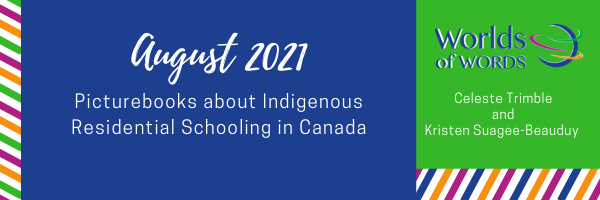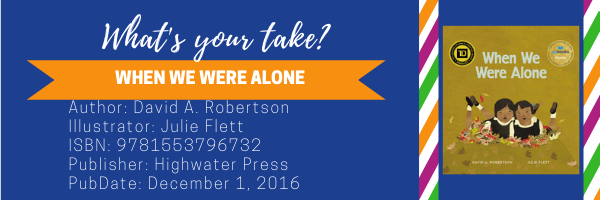By Celeste Trimble and Kristen Suagee-Beauduy

For the month of August Kristen Suagee-Beauduy and Celeste Trimble take a closer look at the youngest picturebooks about Indigenous residential schooling in Canada. When We Were Alone, written by David A. Robertson (Swampy Cree) and illustrated by Julie Flett (Cree-Metis), tells the story of a contemporary conversation between a First Nations grandmother and her granddaughter. The grandchild asks questions such as: “Why do you wear bright colors?” “Why do you wear your hair long?” “Why do you speak in Cree?”

Each question in this book is answered in this specific and patterned way.
“When I was your age, at home in my community…”
“…but at the school I went to, far away from home….”
“But sometimes…when we were alone….”
“Now, I always….”
Grandmother explains what it was like before she was taken to an Indian Residential School, then she explains how her traditions were taken away from her at school. She describes moments when she and her friends at school could comfort themselves with memories or practices from their home communities. Finally, she answers the question about why she does things a certain way now, indicating that her experiences at residential school deeply impacted her life, and she makes life choices to try to erase the harm done to her during that time in her life.
CELESTE: There is so much love evident in this book. The granddaughter is caring and helpful. But, noticeably, she is so observant of her grandmother. She seems to know her deeply, not only through her care and observations, but also because there is a comfort in the way the granddaughter asks questions. It is evident that these two are very close. I love seeing relationships between grandparents and grandchildren in youth literature!
Part of my love of this relationship is that the existence of this relationship, especially with the closeness and tenderness that we see, is part of the story. In a way it shows the reader that culture, traditions and family are strong and resilient, and that the experience of residential schooling did not take these things away forever for the family in this story, despite the Government and Church mission to do so.
One difficult thing for me in this story is that I know the positivity in this book is not how the experience of residential schooling went for many others. But Robertson and Flett do a wonderful job of balancing this painful history with the power of hope and resilience, which is an important aspect of youth literature.
KRISTEN: The message of hope and resilience is important for everyone, especially Indigenous people, to hear. The grandmother is an ideal survivor of the boarding school experience. She shows us that cultural maintenance takes time and practice. I’ve read that it’s likely that 40,000 of the students who attended boarding schools in the United States died because of their poor treatment. To survive that experience, maintain some of her traditional culture and be able to share it with her granddaughter is the best possible scenario. It’s a story that should be celebrated.
My grandfather was very proud to be Native but taught us little about being Cherokee. I resented him for that. I knew he went to the Chilocco Indian School as a child in Oklahoma, but I don’t remember learning about the damage that kind of boarding school did to Native communities until I was minoring in American Indian Studies as an undergrad. In college I learned that the federal government in the United States decided it was cheaper to send Native kids to boarding school and kill the culture than it was to keep killing people in the Indian Wars.
I wonder if I had been read books like When We Were Alone if I could have had a better relationship with my grandfather and his daughter. Maybe a parent or teacher or therapist could have helped us have a conversation about forced assimilation. Maybe we could have used the book to have a conversation with our Cherokee community about cultural reclamation. Maybe this book can be that kind of tool for the folks trying to grapple with the bodies of children being found at residential schools in Canada.
CELESTE: This book could absolutely be a tool for discussion and learning about residential schooling in both Canada and the U.S. at many ages. And after the uncovering of the remains of children at Kamloops and other schools in Canada, many non-Indigenous people have been shocked, having learned about the experience of the abuses in residential schooling for the first time. For many in Indigenous communities, this news is not new but merely evidence of what is already known.
It is important that this book is meant for, appropriate for, young children. Sometimes people think we cannot discuss the pains of our historical past, and certainly not the pains of how the past affects the present, with young children. But this book shows not only HOW we can discuss these things with the young, but that it is necessary to do so. Your comment of wishing that you had been able to talk about this with your grandfather in more depth is a great example of the impact this book could make not only on larger communities, but on individual relationships and families.
KRISTEN: You were talking about how some people are learning about Indian boarding schools for the first time. That’s good, but there’s still so much to learn even if you’ve read the books about them by Native scholars because so much of the bookkeeping never found its way into the historical record. In 2012 The National Native American Boarding School Healing Coalition was founded, and they’ve been trying to collect records from the hundreds of Indian boarding schools that existed in the U.S. but they’ve only been able to pull data from something like 37% of the schools. That number, along with the thousands of children found in Canada says to me that this is a moment of reckoning. Introducing this information to children through story is one way that we can create an environment where children are allowed to see an ugly side of history that educators are finding harder to teach about now that we’re seeing this backlash against Critical Race Theory.
Shifting gears, I’d like to talk about the book’s visual rhetoric, supplied by artist Julie Flett. I so appreciate a Native-authored book illustrated by another Native person. I like the art in this book more than I like Julie Flett’s illustrations in the other books I’ve seen from her (The Girl and the Wolf, Wild Berries, On the Trapline, Johnny’s Pheasant, and Birdsong) mostly because the colors are brighter. Take the first page for example. The dominant color is red, which has symbolism to me as a Native and a Cherokee. Red is the color our Cherokee warriors wear. And red has also come to represent the pan-Indian MMIW movement where activists and everyday people wear red in remembrance of Missing and Murdered Indigenous Women to strategically draw attention to the fact that Indigenous women, girls and femme-presenting people are abducted and killed at higher rates than any other demographic in the U.S. and Canada. I can’t think of a better color to represent Indigeneity because it symbolizes strength at the same time as representing what needs to change in the face of adversity. So back to the first page—there are different shades of red used in the grandmother’s skirt, the granddaughter’s bottom half and in the flowers the two are reaching for. If we’re talking about visual rhetoric, Flett is telling us that these two characters are different but deeply connected.
What did you think about the illustrations?
CELESTE: I love Flett’s work, and it is interesting that you perceive this book differently based on the use of color. One of the things that I appreciate in her work in general is that she has a recognizable style, a quiet illustration style. However, in this book she uses color to make the realities of life at residential school visibly different from when the children were alone and life at home in community. The images away from the school, either when they are having a contemporary conversation, or when they were alone, are definitely more colorful, brighter, more full of joy and life. This, of course, is a part of the text as well, when the child asks Nókom why she wears such colorful clothes, both of their faces are turned away from the reader, as they work in the garden. On the following page, most of the color is gone, and the grim faces of the children starkly contrast from the illustration showing the children covering themselves in colorful leaves when they are alone. This pattern continues through the entire book.
One image that I find incredibly striking is the image of the child getting their hair cut. Like the images of the girl and her grandmother in the garden, both the character’s backs are to the reader, but this image is almost entirely devoid of color. The hair is scattered on the ground, not around the child, but across the page, looking like it’s flowing like spilled water or tears off the page. The adult cutting the child’s hair has a shadow, but the child has no shadow. This makes me think about all the children who did not survive, both those who literally perished at the “schools” as well as those who were harmed irreparably. It’s an emotionally charged image.
KRISTEN: I am surprised this image made you feel so deeply without being able to connect it to how hair is seen in many tribal communities. It’s my understanding that hair being cut at boarding schools was so wrong because many tribes only cut their hair during ceremony to mourn the loss of a loved one, and for hair to be cut without the student’s consent is deeply disrespectful because it disallowed them to practice their religion. For this reason, the act of cutting someone’s hair is pretty much the most symbolic act of forced assimilation there is. I think that’s why it’s on the cover of I Am Not a Number.
I’d like to mention that I really appreciate the Cree words in Robertson’s book–one of the exciting things about being a reader in this era is the ability of Native authors to express cultural sovereignty through their work. Language is the vessel that holds culture. You can find studies that show kids have greater self-esteem when they read books that reflect their communities. A book that showcases words in a kid’s Indigenous language is a great way to signal to them that they matter.
Title: When We Were Alone
Author: David A. Robertson
Illustrator: Julie Flett
ISBN: 9781553796732
Publisher: Highwater Press
PubDate: December 1, 2016
Throughout August 2021, Celeste Trimble and Kristen Suagee-Beauduy discuss four recently published picturebooks about indigenous residential schooling in Canada. Check back each Wednesday to follow the conversation!
- Themes: Celeste Trimble, David A. Robertson, Julie Flett, Kristen Suagee-Beauduy, When We Were Alone
- Descriptors: Books & Resources, My Take/Your Take
